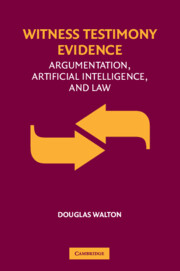Book contents
- Frontmatter
- Contents
- List of Figures and Tables
- Acknowledgments
- Introduction
- 1 Witness Testimony as Argumentation
- 2 Plausible Reasoning in Legal Argumentation
- 3 Scripts, Stories, and Anchored Narratives
- 4 Computational Dialectics
- 5 Witness Examination as Peirastic Dialogue
- 6 Applying Dialectical Models to the Trial
- 7 Supporting and Attacking Witness Testimony
- Bibliography
- Index
7 - Supporting and Attacking Witness Testimony
Published online by Cambridge University Press: 03 February 2010
- Frontmatter
- Contents
- List of Figures and Tables
- Acknowledgments
- Introduction
- 1 Witness Testimony as Argumentation
- 2 Plausible Reasoning in Legal Argumentation
- 3 Scripts, Stories, and Anchored Narratives
- 4 Computational Dialectics
- 5 Witness Examination as Peirastic Dialogue
- 6 Applying Dialectical Models to the Trial
- 7 Supporting and Attacking Witness Testimony
- Bibliography
- Index
Summary
We begin this chapter by analyzing how evidence supporting witness testimony can be modeled as a kind of argumentation. This takes us back to the problems we encountered in Chapter 1 concerning the representation of corroborative evidence using argumentation technology. We continue the chapter by analyzing how argumentation that questions, attacks, or defeats arguments from witness testimony can be modeled. The second task is the more challenging of the two, because, as we have seen in the previous chapters, attacking witness testimony involves scripts and stories, and the kind of plausible reasoning used to support and to attack the arguments in them. In addition, we have seen that the engine for questioning in attacking witness testimony is the examination dialogue, and this type of dialogue has been so little studied in the literature on argumentation, artificial intelligence, and law that any attempt to apply it to witness testimony evidence is pioneering work. At present, the aim of much of this work is to develop systems of argumentation that might lead to applications in law in the not too distant future. However, because the theory of examination dialogue presented in this book is so new, even in argumentation theory, there is an additional task of showing how witness testimony can be formalized in such systems and implemented in computer programs for legal reasoning. The existing systems model arguments as sets of propositions, as premises and conclusions and arguments linked together to form chains of reasoning.
- Type
- Chapter
- Information
- Witness Testimony EvidenceArgumentation and the Law, pp. 296 - 338Publisher: Cambridge University PressPrint publication year: 2007



